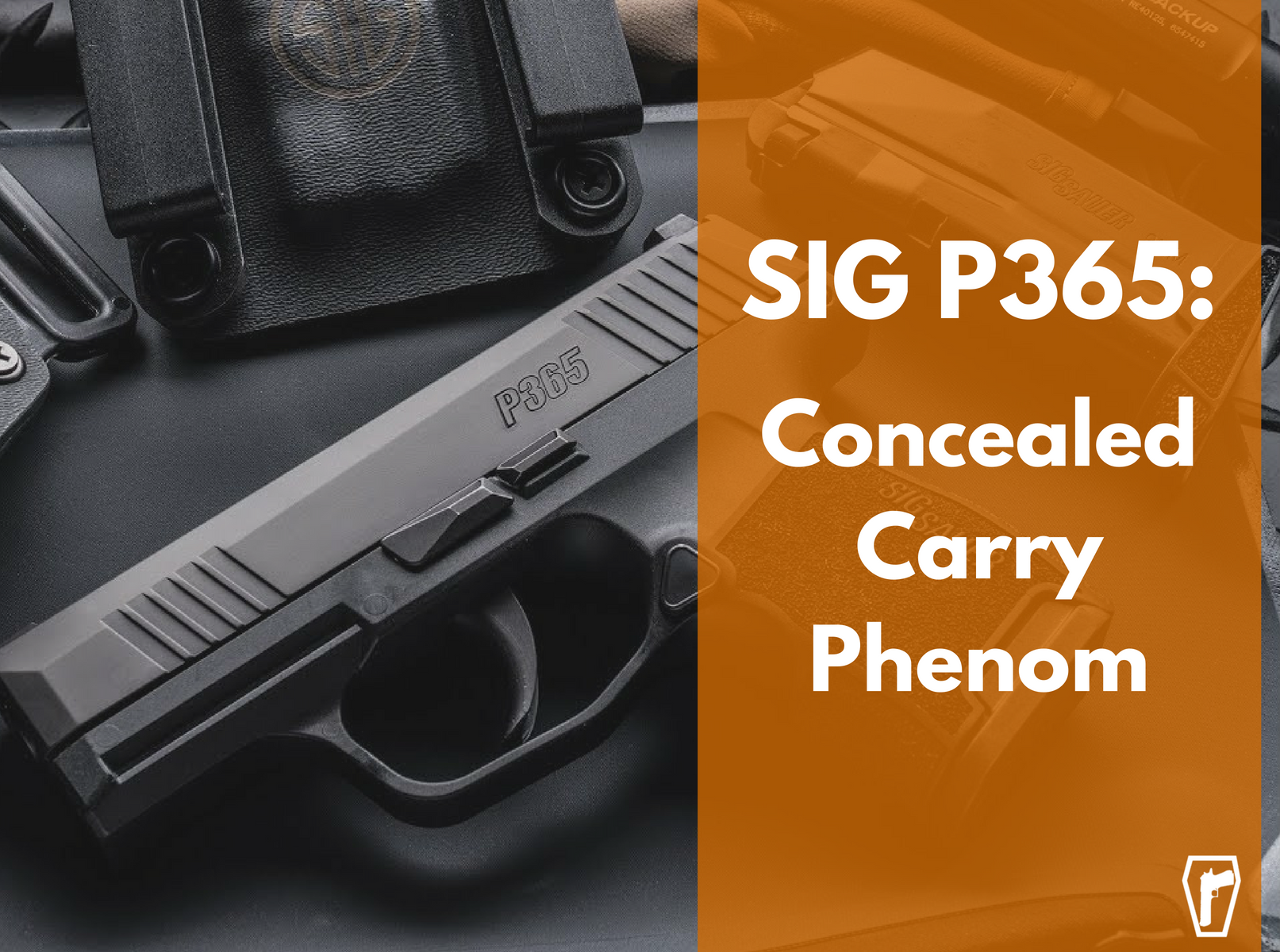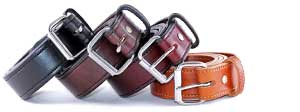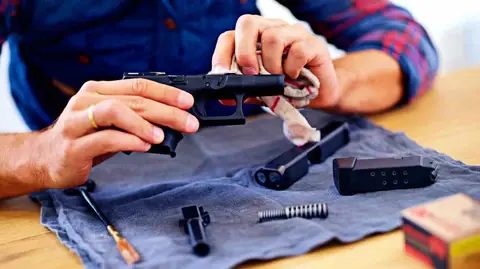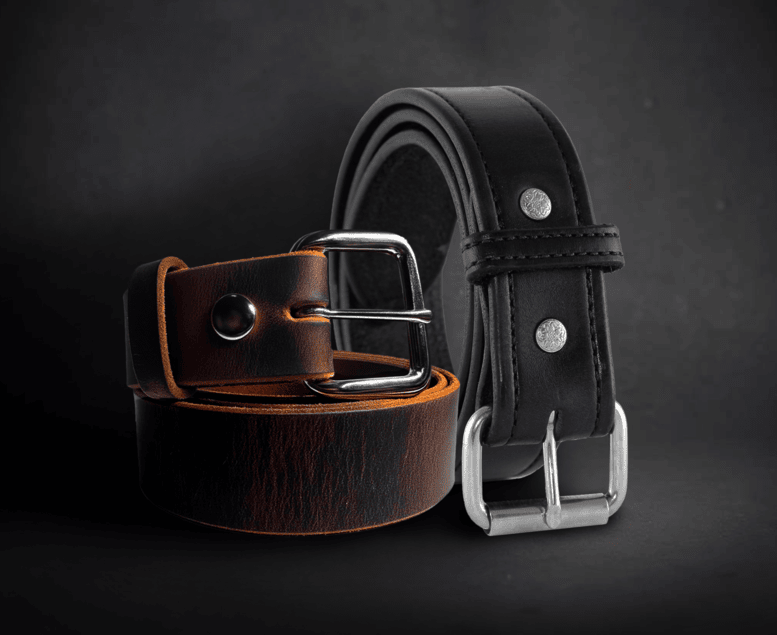SIG P365 Full Review

Full Review of the SIG P365: A Concealed Carry Phenom
SIG Sauer unveiled the P365 at the 2018 SHOT Show, subsequently sending everyone and their cousins into a frenzy of either pure joy or loathsome hatred for the little micro-compact striker fired pistol.
Here are the specs on SIG’s micro-compact wonder:
MSRP: $599
Caliber: 9mm
Capacity: 10+1 in the flush-fit and pinky extensions mags; 12+1 in extended mag
Weight: 17.8 oz. (empty magazine)
Sights: XRAY-3 Day/Night Sights (3-dot with tritium inserts)
Trigger: ~5 lbs.
Overall Length: 5.8”
Barrel Length: 3.1”
Width: 1.0”
Height: 4.3” with flush fit magazine; 5.8” with extended magazine
Slide: Stainless Steel, Nitron finish
If you want to carry the P365 in the G2 holster, you'll want the Trooper size. We're working on a Shell for the P365 for our REVO Modular Holster System, too.
SIG is hailing the P365 as the ultimate concealed carry pistol, and while we seem to hear that every year about every manufacturers new pistol, SIG’s claim may be more than hype. Check out their video below.
What makes the P365 so interesting is that it’s about the size of a mosquito but packs the wallop of a mad hornet. In other words, compared to the similarly sized Glock 43 that carries a flush fit magazine of 6+1, the P365 is bringing you four more rounds at 10+1.
And that’s just in their flush fit magazine; with the extended mag, which only adds a touch of height to the gun but brings you to a total round capacity of 12+1. For those of you like me who don’t do math in your head, that’s only three rounds less than the much larger Glock 19 at 15+1.
Let’s just take a second and give SIG a round of applause. That’s pretty impressive, regardless of your other thoughts on the P365, and it bears some respect for a design innovation.
The folks over at SIG Sauer built this handy-dandy concealed carry gun around the magazine, specifically for people to carry, you guessed it, 365 days a year. The year round carry gun, something every manufacturer has been chasing since concealed carry exploded in popularity a few years ago.
And SIG pretty much nailed it. You may have heard about some issues with the earlier runs of the P365, such as drop failures or striker drag, but SIG has taken care of those issues and the P365 is running strong.
Let’s take a look at some of the specifications on the Sig P365, and see how it stacks up against some other popular concealed carry guns.
Range Performance
Shooting the P365 was a good experience. There was some hesitancy about whether or not recoil would become a significant factor in handling the little gem, especially with +P rounds, but it proved capable of handling everything we fed it. We expected it to be a little snappy, but even with higher pressure loads, recoil was very manageable and we all placed solid groups with the P365.
Achieving a solid grip on the gun was pretty easy, but things really felt right when using the extended 12-round magazine. The extra length allowed for a full, comfortable grip, and the SIG factory stippling did its job well. If you prefer more aggressive grip texture though, you may want to try out the SIG P365 Talon grips.
Not only is the P365 smaller in many areas, it also felt sleeker. Subjective, I know, but when you look an irregular measurement like distance between the frontstrap and backstrap (depth) of the grip, the P365 is again smaller. Which brings us back around to the irregularity of how such a small-gripped pistol can hold so many rounds.
We know SIG started design around the magazine; as mentioned, this gun was intentionally made for everyday concealed carry, and it shows. The new kid on the block boasts slimmer features in almost every way. One difference is that the SIG’s slide lock lever is not recessed into the frame, nor is the takedown lever.
This is one of the (very) few things I was critical about. I would like to see at least a recessed takedown lever on this gun to make it even slimmer. A takedown lever like the one on the Hudson H9, that is actually set into the frame, would work beautifully on the P365, and a slightly recessed slide release would improve the “concealability” factor of this gun, too.
In mentioning the takedown lever, I’m compelled to say that like all other SIG Sauer pistols I know of, breaking the gun down doesn’t require pulling the trigger. Of course, you’ll still want to ensure you’re handling a clear weapon, but takedown is a simple three-point process. Lock the slide to the rear, rotate the takedown lever, and then (gently) send the slide forward. Slide comes off and voila; you can now get to cleaning your weapon.
The barrel has a flat muzzle crown, and sits flush with the slide, which gives it an appealing look. The barrel barely breaks the three-inch mark at 3.1 inches. The feed ramp is smooth, and there’s an ample ejection port and hefty extractor to prevent ye olde stovepipe malfunction.
The trigger on this gun is getting overlooked due to the magazine capacity, but it’s one to appreciate. The trigger break was right around 6 pounds for us, but we’ve seen a range from 5.5 lbs. up to 6.5 lbs. in other reviews.
The trigger was smooth, leading to a crisp break. No grit, no mushy slack and a short reset. Not as light as a single-action gun, but for a defensive gun with no external safeties, that’s just fine.
The trigger guard is large; it actually looks oversized on the micro-compact frame. There’s also a very well shaped and positioned undercut on the trigger guard, allowing for a higher grip.
The undercut, along with other features like the grip width and depth, subtle finger groove, and the angle of the backstrap all combine for incredible ergonomics. We all enjoyed how the P365 felt in our hands, and personally I’d love to see a full-size P365; keep everything the same, just make it bigger. This is more out of curiosity, but I just know that a full-size gun with these ergonomics would be perfect in hand.
The P365 factory sights are fantastic, especially when you consider that you’re getting night sights on the baseline pistol. You won’t get that with the base models of similar pistols like the Glock 43 or Shield. Even though the P365 is a more expensive gun than the G43 or Shield, you’re getting a more well rounded defensive carry option in the baseline model.
The X-RAY3 sights on the P365 works well in both day and night-time conditions, with the 3-dot tritium sights glowing at night and the white dots are bright for daylight use. The sight body is made from steel, so these rugged sights will last for a very long time even in rough, everyday use.
As of this writing, there aren’t any options for mounted optics like an RMR. You can switch out the 3-dot sights of course, but why would you want to? The XRAY-3 sights are fantastic. Maybe we will see a manufacturer in the near future come out with a mini red-dot for the P365; there’s some for the Shield already, but they haven’t been tested with the P365 yet.
The rail on the P365 is SIG’s proprietary rail, meaning it can only be used with SIG attachments. You can buy rail adapters, but if you decide to run a light on this gun, the SIG FOXTROT1 is a great illumination option.
The FOXTROT1 can be used on a Picatinny or SIG rail, so you can transfer it to other weapons as well. This is great if you have a duty weapon or home defense weapon, you can just switch the light to different guns.
There’s also the LIMA365, a laser grip module made specifically for the P365, that comes in a red or green option. The LIMA365 has an instinctive switch on the front of the grip, so that really reduces steps to getting on target if you want to use a laser.
The mags included with the P365 are two 10-round magazines – one flush fit and one with a pinky extension. The 12-round extended magazine costs $55.00 but it’s worth it for the improved grip and capacity. SIG achieved this magazine capacity using a modified double stack design, what they’ve referred to as “a stack and a half.” It makes sense, and it clearly works.
A great carry setup for the P365 would be the 12-round magazine in the gun, then the 10-round mag with the pinky extension in your first reload position, and the flush fit mag in the second reload position, if you want to carry two additional magazines.
The engineering used by SIG Sauer to build the P365 magazines is a huge innovation, not just for concealed carry guns but full-size firearms as well. Think about it like this: If instead of 15 rounds in your standard Glock 19 mag, you could actually fit 19+1 (or something along those lines – this is from comparing the mag capacity of the P365 vs. the Glock 43, 10 vs. 6).
Four extra rounds is a big difference! And when you apply that math to spare mags, your firepower potential gets a nice uptick.
Loading the magazines was easy, and the new mags didn’t give any of us too much trouble even on the last round or two. The UpLULA works with the P365 magazines, and did make reloading much easier during a full day at the range. If you shoot regularly (and you should), then getting a mag loader is a definite yes. It will work with most of your other mags as well.
Speaking of reloading, we put over 1,000 rounds of various ammunition through the little guy in one day. Everything from junk ball ammo to defensive loads and everything in between that we had, we shot. We experienced no failures to feed, failures to eject, failures to fire or magazine issues.
Tap-Rack-Bang never visited our corner of the range on that trip. Having said that, this was our experience; your mileage may vary, but it seems like SIG has cleared up many, if not all, of the issues of the early rounds of the P365.
Not to rip off Goldilocks, but the forward and rear cocking serrations were just right. While the slide is registered at one inch wide, it’s dehorned and trimmed down in various spots, making it feel more slim than it is.
When you compare the width of the P365 to something like the Glock 26, which also holds 10+1, the G26 feels like a 2x4. The Glock 26 is about a quarter of an inch wider than the P365; a significant difference, when you consider they have the same round capacity with standard mags. Of course, with the G26, you can use full size magazines and even the 33-round Big Stick if you want, which isn't the case for the P365.
Don’t get me wrong, I love the Glock 26; it’s proven itself to many others and me for years, but the difference in comfort was tremendous. When you have the opportunity to carry the same amount or more rounds in a gun that’s much easier to conceal, I think you take it.
Our tale of the tape chart above shows that in the SIG P365 vs. the Glock 43 vs. M&P Shield 2.0 debate, the SIG wins. Of course, that’s on paper, but taking it out to the range proved it all the more in our opinion.
The one thing I would say is that before fully committing to it as my everyday carry gun, I’m going to want to perform a “P365 torture test” to see how it holds up in adverse conditions. Always better to discover problems on the range than on the street. The Glock 26, M&P Shield (original and 2.0) and the Glock 43 have all made it through similar adventures, and I really believe that the SIG will too.
It remains to be seen whether or not the SIG P365 will be the new concealed carry standard, but things are looking up for the micro-compact pistol. With all the issues ironed out, there’s no reason it couldn’t replace the Baby Glocks or Shields for some people, and as new accessories are made for it, the versatility of the P365 will increase.
With the ability to carry 13 rounds, attach a light or laser, and use +P rounds, the SIG P365 may be a good consideration for an all-in-one gun, for home defense and concealed carry.
If you’re in the market for a high-quality defensive handgun, the P365 should be it.
Do you have any experience with the SIG P365? If so, share it with in the comments!










